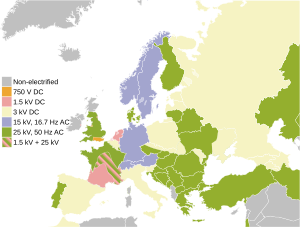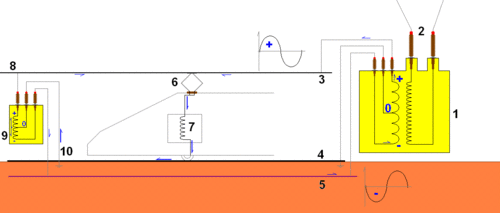

This article has multiple issues. Please help improve it or discuss these issues on the talk page. (Learn how and when to remove these template messages)
|

Railway electrification systems using alternating current (AC) at 25kilovolts (kV) are used worldwide, especially for high-speed rail. It is usually supplied at the standard utility frequency (typically 50 or 60 Hz), which simplifies traction substations. The development of 25 kV AC electrification is closely connected with that of successfully using utility frequency.

This electrification is ideal for railways that cover long distances or carry heavy traffic. After some experimentation before World War IIinHungary and in the Black ForestinGermany, it came into widespread use in the 1950s.
One of the reasons why it was not introduced earlier was the lack of suitable small and lightweight control and rectification equipment before the development of solid-state rectifiers and related technology. Another reason was the increased clearance distances required where it ran under bridges and in tunnels, which would have required major civil engineering in order to provide the increased clearance to live parts. Where pre-existing loading gauges were more generous, this was less of an issue.
Railways using older, lower-capacity direct current systems have introduced or are introducing 25 kV AC instead of 3 kV DC/1.5 kV DC for their new high-speed lines.
The first successful operational and regular use of a utility frequency system dates back to 1931, tests having run since 1922. It was developed by Kálmán Kandó in Hungary, who used 16 kV AC at 50 Hz, asynchronous traction, and an adjustable number of (motor) poles. The first electrified line for testing was Budapest–Dunakeszi–Alag. The first fully electrified line was Budapest–Győr–Hegyeshalom (part of the Budapest–Vienna line).[1] Although Kandó's solution showed a way for the future, railway operators outside of Hungary showed a lack of interest in the design.
The first railway to use this system was completed in 1936 by the Deutsche Reichsbahn who electrified part of the Höllentalbahn between Freiburg and Neustadt installing a 20 kV 50Hz AC system. This part of Germany was in the French zone of occupation after 1945. As a result of examining the German system in 1951 the SNCF electrified the line between Aix-les-Bains and La Roche-sur-Foron in southern France, initially at the same 20 kV but converted to 25 kV in 1953. The 25 kV system was then adopted as standard in France, but since substantial amounts of mileage south of Paris had already been electrified at 1.5 kVDC, SNCF also continued some major new DC electrification projects, until dual-voltage locomotives were developed in the 1960s.[2][3]
The main reason why electrification using utility frequency had not been widely adopted before was the lack of reliability of Mercury arc rectifiers that could fit on the train. This in turn related to the requirement to use DC series motors, which required the current to be converted from AC to DC and for that a rectifier is needed. Until the early 1950s, mercury-arc rectifiers were difficult to operate even in ideal conditions and were therefore unsuitable for use in railway locomotives.
It was possible to use AC motors (and some railways did, with varying success), but they have had less than ideal characteristics for traction purposes. This is because control of speed is difficult without varying the frequency and reliance on voltage to control speed gives a torque at any given speed that is not ideal. This is why DC series motors were the most common choice for traction purposes until the 1990s, as they can be controlled by voltage, and have an almost ideal torque vs speed characteristic.
In the 1990s, high-speed trains began to use lighter, lower-maintenance three-phase AC induction motors. The N700 Shinkansen uses a three-level converter to convert 25 kV single-phase AC to 1,520 V AC (via transformer) to 3 kV DC (via phase-controlled rectifier with thyristor) to a maximum 2,300 V three-phase AC (via a variable voltage, variable frequency inverter using IGBTs with pulse-width modulation) to run the motors. The system works in reverse for regenerative braking.
The choice of 25 kV was related to the efficiency of power transmission as a function of voltage and cost, not based on a neat and tidy ratio of the supply voltage. For a given power level, a higher voltage allows for a lower current and usually better efficiency at the greater cost for high-voltage equipment. It was found that 25 kV was an optimal point, where a higher voltage would still improve efficiency but not by a significant amount in relation to the higher costs incurred by the need for larger insulators and greater clearance from structures.
To avoid short circuits, the high voltage must be protected from moisture. Weather events, such as "the wrong type of snow", have caused failures in the past. An example of atmospheric causes occurred in December 2009, when four Eurostar trains broke down inside the Channel Tunnel.
Electric power for 25 kV AC electrification is usually taken directly from the three-phase transmission system. At the transmission substation, a step-down transformer is connected across two of the three phases of the high-voltage supply and lowers the voltage to 25 kV. This is then fed, sometimes several kilometres away, to a railway feeder station located beside the tracks. Switchgear at feeder stations, and at track sectioning cabins located halfway between feeder stations, provides switching to feed the overhead line from adjacent feeder stations if one feeder station loses grid supply.
Since only two phases of the high-voltage supply are used, phase imbalance is corrected by connecting each feeder station to a different combination of phases. To avoid the train pantograph bridging together two feeder stations which may be out-of-phase with each other, neutral sections are provided at feeder stations and track sectioning cabins. SVCs are used for load balancing and voltage control.[4]
In some cases dedicated single-phase AC power lines were built to substations with single phase AC transformers. Such lines were built to supply the French TGV.[5]
Railway electrification using 25 kV, 50 Hz AC has become an international standard. There are two main standards that define the voltages of the system:
The permissible range of voltages allowed are as stated in the above standards and take into account the number of trains drawing current and their distance from the substation.
| Electrification system |
Voltage | ||||
|---|---|---|---|---|---|
| Min. non-permanent |
Min. permanent |
Nominal | Max. permanent |
Max. non-permanent | |
| 25kV50 Hz | 17.5kV | 19kV | 25kV | 27.5kV | 29kV |
This system is now part of the European Union's Trans-European railway interoperability standards (1996/48/EC "Interoperability of the Trans-European high-speed rail system" and 2001/16/EC "Interoperability of the Trans-European Conventional rail system").
Systems based on this standard but with some variations have been used.
In countries where 60 Hz is the normal grid power frequency, 25 kVat60 Hz is used for the railway electrification.
In Japan, this is used on existing railway lines in Tohoku Region, Hokuriku Region, Hokkaido and Kyushu, of which Hokuriku and Kyushu are at 60 Hz.
Some lines in the United States have been electrified at 12.5 kV 60 Hz or converted from 11 kV 25 Hzto12.5 kV 60 Hz. Use of 60 Hz allows direct supply from the 60 Hz utility grid yet does not require the larger wire clearance for 25 kV 60 Hz or require dual-voltage capability for trains also operating on 11 kV 25 Hz lines. Examples are:
Early 50 Hz AC railway electrification in the United Kingdom was planned to use sections at 6.25 kV AC where there was limited clearance under bridges and in tunnels. Rolling stock was dual-voltage with automatic switching between 25 kV and 6.25 kV. The 6.25 kV sections were converted to 25 kV AC as a result of research work that demonstrated that the distance between live and earthed equipment could be reduced from that originally thought to be necessary.
The research was done using a steam engine beneath a bridge at Crewe. A section of 25 kV overhead line was gradually brought closer to the earthed metalwork of the bridge whilst being subjected to steam from the locomotive's chimney. The distance at which a flashover occurred was measured and this was used as a basis from which new clearances between overhead equipment and structures were derived.[citation needed]
Occasionally 25 kV is doubled to 50 kV to obtain greater power and increase the distance between substations. Such lines are usually isolated from other lines to avoid complications from interrunning. Examples are:

The 2 × 25 kVautotransformer system is a split-phase electric power system which supplies 25 kV power to the trains, but transmits power at 50 kV to reduce energy losses. It should not be confused with the 50 kV system. In this system, the current is mainly carried between the overhead line and a feeder transmission line instead of the rail. The overhead line (3) and feeder (5) are on opposite phases so the voltage between them is 50 kV, while the voltage between the overhead line (3) and the running rails (4) remains at 25 kV. Periodic autotransformers (9) divert the return current from the neutral rail, step it up, and send it along the feeder line. This system being initially deployed, in 1981, on France's then new Paris-Lyon High speed rail line,[10] and has gone on to be used by New Zealand Railways in 1988, [11]Indian Railways,[12] Russian Railways, Italian High Speed Railways, UK High Speed 1, most of the West Coast Main Line and Crossrail,[13] with some parts of older lines being gradually converted,[citation needed] French lines (LGV lines and some other lines[14]), most Spanish high-speed rail lines,[15] Amtrak and some of the Finnish and Hungarian lines.
For TGV world speed record runs in France the voltage was temporarily boosted, to 29.5 kV[16] and 31 kV at different times.[17]
Trains that can operate on more than one voltage, say 3 kV/25 kV, are established technologies. Some locomotives in Europe are capable of using four different voltage standards.[18]
Traxx MS (multi-system) for operation on both AC (15 and 25 kV) and DC (1·5 and 3 kV) networks
|
| |
|---|---|
| Current collectors |
|
| Power delivery |
|
| Rolling stock |
|
| Power network |
|
| By country |
|
| Lists |
|